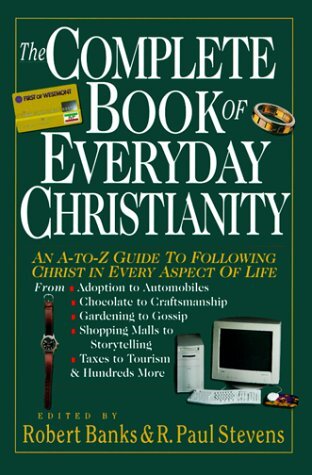Laity
Book / Produced by partner of TOW
George Bernard Shaw once said that every profession is a conspiracy against the laity. But there is a problem with this cynical remark when it is applied to the church. It is pointless to launch a conspiracy against something that no longer exists. The New Testament does not reveal two peoples: the professional clergy (those who are superior, gifted and powerful) and the laity (those who are inferior, untrained and powerless). Rather there is one people: the laity (in Greek laos), which includes the leaders. Moreover the leaders, like the led, are first and foremost members of the laity and share the exquisite honor of the people of God (1 Peter 2:9-10). Indeed the cultivation of professionalism by leaders of the church is incongruous with the essentially amateur nature of all Christian ministry. It is the work of love (as the root meaning of amateur indicates). To recover a biblical perspective on the people of God, we may need to abolish the words laity and clergy. We may also need to reinvent a way of expressing the dignity and duty of the ordinary Christian. In preparation for this we must first examine the biblical data, then reflect theologically on the identity and vocation of the people of God and finally consider what this all means.
Biblical Data
New Testament authors rejected two disparaging “laity” words available to them when describing the people of God under the newly reconstituted covenant in Christ: laikos and idiōtēs. The word laikos (belonging to the common people) is not used at all in the New Testament. It was first used for Christians by Clement of Rome at the end of the first century to describe the place of laity in worship when the presbyters were being deprived of their functions. The other word, idiōtēs, root of the English word idiot, means “layperson in contrast to an expert or specialist.” This pejorative word is much closer to Bernard Shaw’s use of the term laity, but it is never used as a self-description by Christians! In Acts 4:13 members of the Jewish Sanhedrin expressed their amazement that these “unschooled, ordinary men” (in this case the idiōtai were Peter and John) could preach with eloquent power. The word is also used in 1 Cor. 14:23 to describe the outsider who wanders into a Christian meeting and cannot understand what is going on.
Instead of laikos and idiōtēs New Testament writers use two other words. The Greek word laos originally meant “the people or the crowd.” It was eventually employed in the Greek translation of the Old Testament (LXX) as the universal designation for “the people of God” translating the Hebrew am. This word may be properly translated “laity,” but to do so we would need to reinterpret its meaning. It does not mean “untrained” or “ordinary”; rather it means “the people of God” (Acts 15:14; Romans 9:25; 1 Peter 2:9)—a truly extraordinary people—and includes rather than excludes those who were priests. While in the church today we have two classes of people separated by education, ordination and intonation—the laity (who receive the ministry) and the clergy (who give the ministry)—in the New Testament there is only one ministering people with leaders, also members of the laos, serving them to equip the people for the work of the ministry (Ephes. 4:11-12).
Remarkably, the second word used to describe the whole people of God is the Greek word klēros, the word from which our English clergy is derived. The word means “assigned by lot or inheritance” and is used for the privileges and appointment of all the people of God (Galatians 3:29; Ephes. 1:11; Col. 1:12). With the exception of Ignatius of Antioch (who used klēros to describe the martyr), the term was not used for “clergy” until the third century. It is only at that time that the term laity reappears. As Alexandre Faivre shows, laypersons can exist only when they have an opposite against which they can define themselves, and until the second century there simply was no such opposite (p. 23)!
The church in the New Testament has no laypeople in the usual sense of that word and is full of clergy in the true sense of that word. A biblical theology of the laity must communicate this.
A People Without Laity or Clergy
When we step into the church of the New Testament, we meet a single people (laos) marked by universal Spirit-giftedness, priesthood, empowerment, calling and ministry. The church as a whole is the true ministerium, a community of prophets, teachers, priests and princes/princesses serving God through Jesus in the power of the Spirit seven days a week. All are clergy in the sense of being appointed by God to service and dignified as God’s inheritance. All are laity in the sense of having their identity rooted in the people of God. All exercise ministry. All receive ministry. That is the constitution of the church.
But when we step into the modern church, we see something quite different. Deeply ingrained there is the belief that the full-time ministry is the highest human vocation. From the perspective of the New Testament, however, a part-time option has never been available! It is only when a person feels he or she is not able to go into the ministry that the second-best alternative is to spend discretionary time in church-related activities. Instead of the pastor’s becoming an assistant to the people for their ministry in the church and world, equipping thus gets reduced to making paraclergy out of the rest of the members of the church in order to assist the minister.
Not surprisingly, few businesspeople think of themselves as full-time ministers in the marketplace. Fewer still are encouraged in this by their churches. Hardly anyone gets commissioned to service in the world. Christians in the first century would have found such a state of affairs anachronistic—a throwback to the situation before Christ came when only a few in Israel knew the Lord, when only one tribe was named as priests and when only a select few heard the call of God on their lives. Nothing but a Copernican revolution of the mind and heart can change this heretical state of affairs.
Toward a Trinitarian Theology of the Laity
To accomplish this transformation, a theology of the laity that is also a theology by the laity must be written, articulated and embodied. But this theology must not merely explore the identity and vocation of the nonclergy portion of the people. This would be a compensatory theology attempting to overcome seventeen centuries of clericalism. Reactionary theology is neither life-giving nor peaceable, and it is the recovery of the unity of God’s people that is at stake. The apostle Paul was faced in his own day with something roughly parallel to clericalism, namely, performance of the law as a means of gaining righteousness and defining membership. Paul’s approach to the problem gives us an important clue. He went behind discussions of the law to rediscover something that preceded the law and gave it meaning—namely, the promise (Galatians 3:15-18). In a biblical theology of the laity we must get behind the clergy-lay problem that has plagued the church since the third century and find out what God originally intended for his people. To do this we must explore, first, what kind of God we are encountering and, second, what it means to be a people like God.
A fully trinitarian approach is needed, since the identity and ministry of the laos are shaped by the God whose people we are. God has called out “a laos for himself” (Acts 15:14) or as the King James Version puts it, “a people for his name.” If the identity of the laos comes from the Trinity, the vocation of the laos also comes from the triune God. In this way both the being and the doing, both the identity and the vocation, of the laos will be considered.
Trinitarian Ministry
The ministry of the laos is not generated exclusively by the people, whether from duty or gratitude. All ministry is God’s ministry. God’s ministry continues through his people. This ministry begins not when we join the church to help do God’s work but when we join God (John 1:12) and have “fellowship . . . with the Father and with his Son” (1 John 1:3). Laos ministry is participation in the ingoing ministry of God (Father, Son and Spirit) and simultaneously participation in the outgoing (sending) ministry of God. “As you sent me into the world,” said Jesus, “I have sent them into the world” (John 17:18). On the first (the ingoing), God is “lover, the beloved and the love itself,” as Jürgen Moltmann puts it (p. 32). On the second, God is sender, sent and the sending.
So there were ministry and mission within God before there was a world taking place (John 17:5, 24). This precreation ministry was neither curative nor redemptive. There was nothing broken or fallen to restore, even though “the Lamb . . . slain from the creation of the world” (Rev. 13:8) is an evocative hint of God’s redemptive willingness. God’s ministry is creative and unitive (John 17:21-23) as well as curative and redemptive; thus, we find a broader definition of service than is normally ascribed to the term ministry. The same is true of the ministry of the people of God—thus challenging the common evangelical preoccupation with the Great Commission (Matthew 28:19-20) as the exclusive definition of ministry, as important as that mandate is.
Trinitarian Peoplehood
To this rich understanding of peoplehood and ministry each of the three persons of the Godhead contributes. The Father creates, providentially sustains and forms a covenantal framework for all existence. The Son incarnates, transfigures and redeems. The Spirit empowers and fills with God’s own presence. But each shares—coinheres interpenetrates, cooperates—in the others so that it is theologically inappropriate to stereotype the ministry of any one. But that is exactly what happens.
Christians tend to “play favorites” when it comes to describing peoplehood and ministry. For order, providence and sustaining the structures of society we appeal to the Father. The Son is associated with redemption and winning the lost. The Holy Spirit is the focus of those seeking renewal, empowering charisms and direct religious experience. Churches and denominations tend to form around one of the three: Father denominations emphasize reverent worship and stewardship. Son denominations stress discipleship and evangelism, thus furthering the work of the kingdom of God. Spirit denominations promote spiritual gifts and graces. The implications of this specialist approach for peoplehood, vocation and church leadership can be expressed in the following table:
PEOPLEHOOD | VOCATION | LEADERSHIP | |
FATHER | Covenant community | Creational stewardship | Hierarchical |
SON | Kingdom community | Christocratic service | Servant |
SPIRIT | Charismatic community | Exercising gifts; empowerment | Charismatic |
A rich and full doctrine of the Trinity avoids such stereotyping. God is more than the sum of the Three. God is not God apart from the way the Father, Son and Holy Spirit give and receive from each other what they essentially are. “One God”—the primary confession of Islam—is ironically the Christian’s deepest praise. We affirm that God is more One because God is Three. The laos too does not have a “mashed potato” unity, as is sometimes alleged, but a rich social unity in which each member becomes more himself or herself through experiencing an out-of-oneself (ek-static) community life. Unity is not the means to the end—a practical necessity to get the church’s work done. Unity is the end, the goal, the ministry itself (John 17:22; Ephes. 1:10; Ephes. 4:13). To be laos then is not merely to be a bouquet of Christians or a cluster of saints. To be laos means to be simultaneously communal and personal. In the long history of trinitarian reflection, this supreme idea of the personal and interpersonal within God forms the true basis for the identity and vocation of the God-imaging people.
Implications for Laypeople
The implications of this for peoplehood are substantial. Being laos means that members of Christ coinhere, interanimate and pour life into one another without coalescence or merger. The Greek church fathers spoke of this as perichōrēsis, mutual indwelling within God as a model for mutuality in the people of God. It means belonging communally without being communistic or being a collective. Moreover, and pertinent to the clergy-lay dilemma, being a perichoretic people means being a community without hierarchy. The community of Father, Son and Spirit finds its earthly reflection “not in the autocracy of a single ruler but in the democratic community of free people, not in the lordship of man over the woman but in their equal mutuality, not in an ecclesiastical hierarchy but in a fellowship church” (Moltmann, p. viii). Such a community can have leadership and diversity without hierarchy; it can be a community without superiors and subordinates; it can be a church without laity or clergy—in the usual sense of these terms. Three conclusions may be drawn from this.
First, there is no such thing as an individual layperson. If, as I have proposed above, we live out the Christian life interdependently, the individual Christian is an oxymoron. Consistent with the Old Testament, the saints in Paul’s letters are really a unit. The saints are the church, which is the body of Christ. Believers are held together in what can be conceived as a corporate, inclusive personality. It is biblically inconceivable for a person to be a believer in Christ and not be a member of this community. John Wesley once observed that the Bible knows nothing of solitary religion. The believer’s identity is corporate as well as individual. In Christ we can say, “I am us!” Whereas the basic unit of the church is the individual member, for Paul the basic uniqueness of the individual arises from his or her membership in the church.
Second, there is no hierarchy of ministries. In his seminal work on the theology of the laity Hendrik Kraemer says, “All members of the ecclesia have in principle the same calling, responsibility and dignity, have their part in the apostolic and ministerial nature and calling of the church” (p. 160). Incarnating our loving submission to Christ’s lordship in every arena of life precludes saying that certain tasks are in themselves holy and others are sacred. Laos theology is concerned not only about the work of the ministry but also about the ministry of work. William Tyndale, the English Reformer, was considered heretical and executed for teaching, among other things, that “there is no work better than another to please God; to pour water, to wash dishes, to be a souter [cobbler], or an apostle, all are one, as touching the deed, to please God” (p. 98).
Third, supported Christian ministry is not the vocation of vocations but merely one way of responding to the single call that comes to all (Ephes. 4:1). Most expositions about ministry are magnetically attracted to the supreme place of the ordained professional as the minister-par-excellence. It is small wonder that laypersons aspiring to ministry attempt to become amateur clergypersons or paraclergy. There is some reason for this. Work in the church is strategic because the church is the prototype community and the outcropping of the kingdom of God, but work in the church is important only in view of what its members will be and do in society. Church leadership must be evaluated not in terms of its priestly character but by whether the saints are equipped for the work of the ministry seven days a week (Ephes. 4:11-12).
The Recovery of the Amateur Vocation
Meditating on the triune God takes us inevitably to the profound revelation of John 17. In that chapter Christ reflects on the love the Father had for him even before the creation of the world (John 17:24) and prays that the Father’s love may be in the disciples (John 17:26) while disciples and Master, disciple and disciple, and Son and Father all mutually indwell one another (John 17:22-23, 26). This gives new and deeper meaning to the well-worn text “God is love” (1 John 4:16). Love is not merely an attribute of God, but love is who God is and what God does. That is what Moltmann meant when he reflected on a line by Augustine that God is “lover, the beloved and the love itself” (p. 58). This was also expressed by the trinitarian theologian John Duns Scotus (c. 1265-1308) when he affirmed that creation and redemption flow out of the love that is within God. The world was made by love, runs on love and will end with a glorious eternal love-in. In the same way love is the being and the doing of the laos.
The laity does not get its ministry from doing good works on earth to please God but from participating in the love life of God the lover, beloved and love. In the same way the laity gets its mission by participating in the mission of God. The Father sent the Son; the Son sends the laos “as the Father has sent me” (John 20:21; compare John 17:18). Lay mission derives from the outgoing serving heart of God, who is missionary, missionized and mission all at once. To be true to our dignity, duty and destiny as the people of God, we do not “do” ministry or “have” a mission. We are ministry and are mission insofar as we truly are the people of God.
“Only a layperson” is a phrase that must never be found on our lips. It is irreverent and demeaning. It denies that God has adopted, called, empowered and gifted us to receive the incredible privilege of being colovers of God, lovers of one another and those who share God’s love for the world. This is our identity—a molecular social identity. The duke of Windsor, recalling his upbringing in the royal house of King George V, claimed that every day his father would say, “Never forget who you are.” Better yet is never to forget whose we are. We are not laikoi or idiōtēs. We are laos and klēros. Laity in the popular sense no longer exists in Christ. It is useless to mount a conspiracy against it by promoting professionalism in ministry. It is equally ludicrous to liberate such a laity. Why try to liberate what is no longer alive? That people—segmented into higher and lower, subject and object of ministry, ministers and “their” people—no longer exists except as a tragic anachronism. Instead, there is the laos of the triune God. We get our identity and our vocation from being the people of the triune God. And the ministry of that people is to love and be loved. It is so sublimely simple that we could miss its reverent beauty and its life-giving potential.
» See also: Clergy
» See also: Equipping
» See also: Ministry
References and Resources
E. Best, One Body in Christ: A Study in the Relationship of the Church to Christ in the Epistles of the Apostle Paul (London: SPCK, 1955); A. Faivre, The Emergence of the Laity in the Early Church (New York: Paulist, 1990); C. Gunton, The One, the Three and the Many: God, Creation and the Culture of Modernity (Cambridge: Cambridge University Press, 1993); J. Houston, “Trinity and the Christian Life,” lecture at Regent College, Vancouver, B.C., 1994; E. Hui, “Trinity and Creation,” lecture at Regent College, Vancouver, B.C., 1994; H. Kraemer, A Theology of the Laity (Philadelphia: Westminster, 1958); J. Moltmann, The Trinity and the Kingdom, trans. M. Kohl (San Francisco: Harper & Row, 1991); G. Ogden, The New Reformation: Returning the Ministry to the People of God (Grand Rapids: Zondervan, 1990); R. P. Stevens, Liberating the Laity (Downers Grove, Ill.: InterVarsity Press, 1985); W. Tyndale, “A Parable of the Wicked Mammon” (1527), in Doctrinal Treatises and Introductions to Different Portions of the Holy Scriptures by W. Tyndale, ed. H. Walker (Cambridge: Parker Society/Cambridge University Press, 1848).
—R. Paul Stevens





